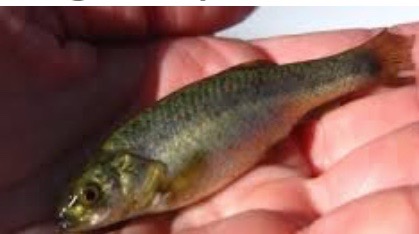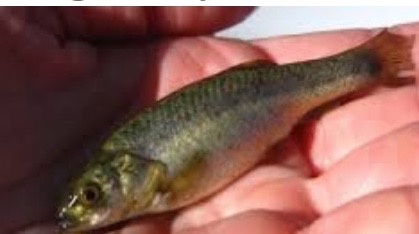Could a tiny fish no longer than a thumb stop the Long Canyon Mine before construction begins?
The fish is called the “Relict Dace” and was mentioned in the formal appeal by the Goshute Tribe against the Bureau of Land Management Approval to the Long Canyon Mine Project.
“The Project Area spans 24,779 acres. Earth-moving activities during mine construction and operation will degrade 3,879 acres of land surface, occurring both on public and private land. On the west edge of Goshute Valley, the Johnson Springs complex, which is fed by groundwater and which includes Big Springs, forms“a system of springs, potholes, ponds, and outflows.” reads part of the appeal. ”This unique and limited habitat sustains a genetically distinct population of the relict dace (Relictus solitarius). FEIS 3-152 –3-153. “[A]n emergency petition to list the relict dace at Big Springs pursuant to Section 4 of the Endangered Species Act was submitted onJune 27, 2014 by an environmental advocacy group.” FEIS 153. While the U.S.Fish and Wildlife Service(“FWS”) did not emergency list the dace as endangered, the FWS did make a 90-day finding:“we find that the petition presents substantial scientific or commercial information indicating that the petitioned action may be warranted for the relict dace. . .”Federal Register, 80(69): 19262; see Exhibit 3. At present, the FWSis undergoing their 12-month status review of the relict dace to determine whether listing the genetically distinct population is warranted.”
 The relict dace, Relictus solitarius, is an endangered cyprinid fish of the Great Basin of western North America. It is the sole member of its genus. The relict dace occurs in only a handful of habitats in eastern Nevada, all of which were once covered by the prehistoric Lake Lahontan. Locations include the springs of Buttle and Ruby Valleys, and the drainage systems of Franklin Lake and Gale Lake.
The relict dace, Relictus solitarius, is an endangered cyprinid fish of the Great Basin of western North America. It is the sole member of its genus. The relict dace occurs in only a handful of habitats in eastern Nevada, all of which were once covered by the prehistoric Lake Lahontan. Locations include the springs of Buttle and Ruby Valleys, and the drainage systems of Franklin Lake and Gale Lake.
The mention of the dace was almost a foot note in the appeal submitted by the Goshutes against the mine two weeks ago.
In a motion to halt all work on the mine filed by Goshute Attorney Paul Echo Hawk the Goshutes claim that the Long Canyon area contains hundreds if not thousands of Paleo Native American artifacts that would be destroyed by the construction and operation of the mine.
Two weeks ago Ibapah’s Goshute Indian tribe filed an appeal with the Department of Interior that, if granted, would derail or at least delay the Long Canyon Mine project 30 miles west of Wendover.
Hiring began for the Long Canyon Mine a month ago after the final government okay to begin the mine’s construction.
 “We think we have made a compelling case not only for a successful appeal but also for an immediate halt of construction,” said Goshute attorney Paul Echo Hawk.
“We think we have made a compelling case not only for a successful appeal but also for an immediate halt of construction,” said Goshute attorney Paul Echo Hawk.
According to a press release from the Goshutes the appeal asks the courts to reject the BLM finding that there are no significant archaeological finds within the project.
The massive open-pit mine would permanently destroy or remove thousands of Tribal cultural resources.
“The Long Canyon Mine area is a vitally important part of our cultural history and its destruction will erase a critical part of who we are as a people,” said Zelda Johnny, a Tribal Cultural Monitor and Tribal Council Vice-Chair.
The mention of the fish could be considered a Plan B for opponents of the mine if the appeal fails on the archeology. Orr perhaps a plan C
The 45-page Tribal appeal is supported by documents showing the BLM refused to share known information about Tribal cultural items in the area and that the BLM insisted the Tribe waive legal claims in order to have access to the BLM’s Tribal information.
“How can our Tribe evaluate the impact of this proposed mine when the BLM would not give us access to the information about our historical ties to the site?” said Tribal Chairwoman Madeline Greymountain.
But although insisting that Long Canyon is almost holy Native American Land the Goshutes have brought very little evidence to support their claim.
 While there could be an abundance of arrow heads and pottery shards and several ancient hearths there is little evidence to suggest that the Long Canyon was anything more than a place to get through for the nomadic ancient native peoples that became the Shoshone and the Goshutes.
While there could be an abundance of arrow heads and pottery shards and several ancient hearths there is little evidence to suggest that the Long Canyon was anything more than a place to get through for the nomadic ancient native peoples that became the Shoshone and the Goshutes.
According to Zelda Johnny so far no petroglyphs, signs of long term settlements or agriculture have been discovered.
The dearth of such artifacts helps the mining company and the BLM in two distinct ways. Bureacratically the lack of artistic artifacts supports the claim that the area was not spiritually important to the paleo Indians. The lack of such artifacts also means that the enthusiasm against the mine would be more difficult to generate and maintain.
According to some reports the Goshutes may believe a rumor that the BLM or even Newmont is keeping what would be considered very significant finds secret and away from the Goshutes.
It is one thing to seek to protect rock art created by an ancient Indian from the last ice age but it is impossible to feel the same emotional bond to a hearth dug in the ground no matter how old that hole is.
The Goshute administrative appeal is a required first step in the appeal process. “The Tribe is committed to forcing the BLM to follow the law and allow the Tribe a full and fair opportunity to participate in the federal review process before this special place and tribal artifacts are permanently destroyed forever. The BLM has failed its trust responsibility in this case,” said Echo Hawk.


